
This week’s edition of Speed Read is a pick ‘n’ mix of interesting machines from all over. We start with a Yamaha MT-25 from Indonesia, then look at Australia’s fastest Honda CT90. A Danish company offers us an electric bike with a suitcase for a tank, then a German garage builder transforms a 1990s Triumph Thunderbird Sport.
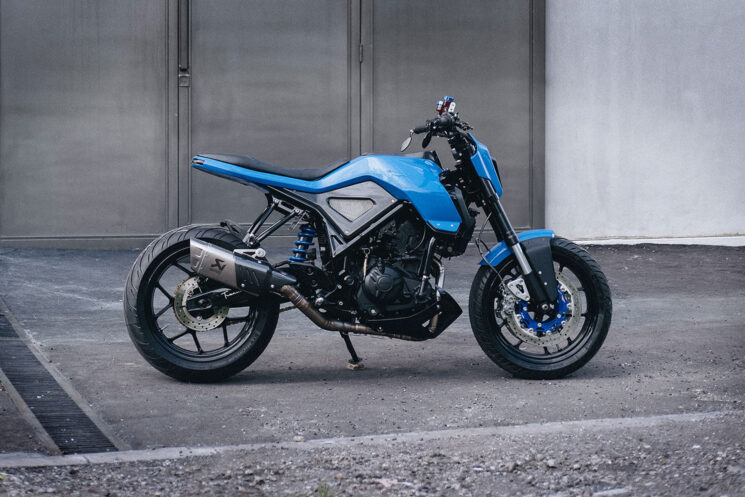
Yamaha MT-25 by Treasure Garage Underlining the extreme popularity of Yamaha’s naked MT range is a fascinating fact; you can buy an MT with as few as one or as many as four cylinders, depending on where you live in the world. We can’t think of another manufacturer who has this level of versatility in their range.
We’re looking at the smaller end of the MT spectrum today with this 249 cc, twin-cylinder Yamaha MT-25 street tracker. It’s been artfully reworked by Imanuel ‘Nuel’ Prakoso and his outfit in Bali, Treasure Garage.
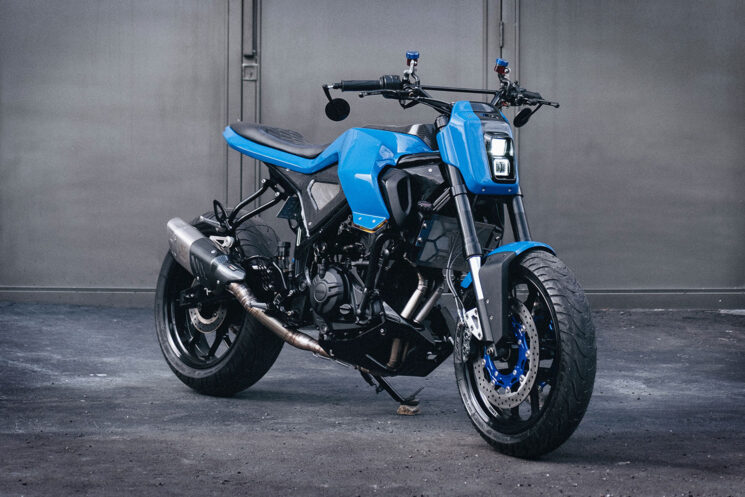
Due to budget constraints, the team started with an older model as a donor bike. Earlier models had spindly little front forks so they started by ripping these off. A set of upside-down forks from a later model MT was installed, along with a twin braking setup.
Blessedly, the stock MT fairing and lighting also found their way into the bin. In its place is a custom unit, complete with twin stacked LEDs. It looks approximately 3,995,739 times better than the factory design.

All the bikes’ bodywork was actually replaced, shaped by hand from sheet metal. After the rear subframe was shortened, the single-piece tank cover and seat unit was designed to fit over the MT’s awkward frame design. The ‘winglets’ on either side of the tank house some sneaky custom indicators, for the eagle-eyed amongst you.
The side covers and top tank cover were crafted from carbon fiber, which looks great against the blue paint. The diamond-embossed black seat with contrasting blue stitching ties into the overall theme perfectly.
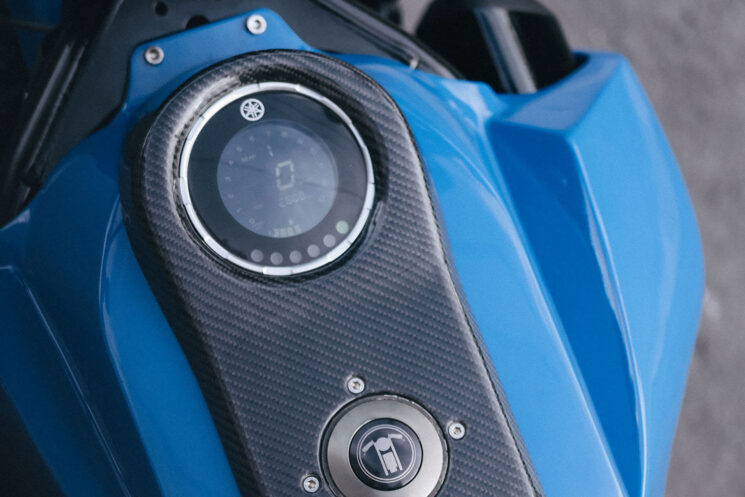
The bike’s instruments were integrated into the carbon fiber part of the tank cover for a clear view over the new handlebars. Sporting all-black grips, switches and mirrors, it’s got a mean look to it that we are all about.
The engine was left mostly alone. However, like most great custom builds, this one sports a full custom exhaust system, terminating in an Akrapovič muffler with a carbon cover. A pair of Michelin Pilot Sport tires were spooned on, rounding out the build sheet.
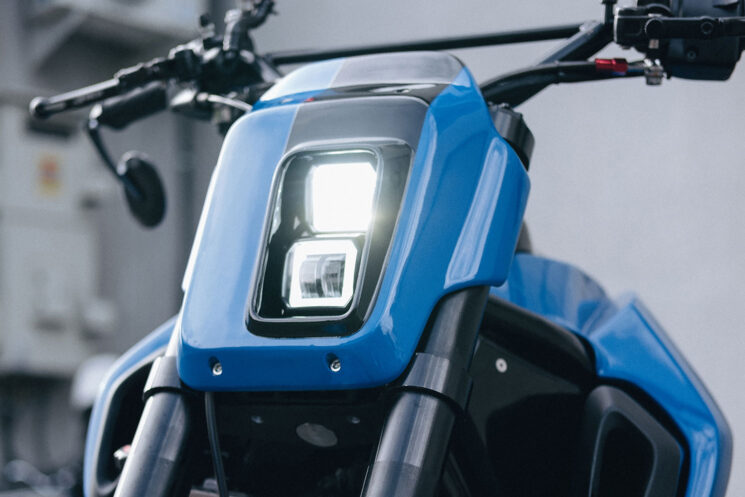
We don’t know many people who would call the factory Yamaha MT-25 good looking, so what Treasure Garage has done is exemplary. With the high quality of the finishes, you wouldn’t for one second think this was a ‘budget’ build.
You could say they are providing a valuable public service, by saving the world, one ugly MT at a time. [Source]
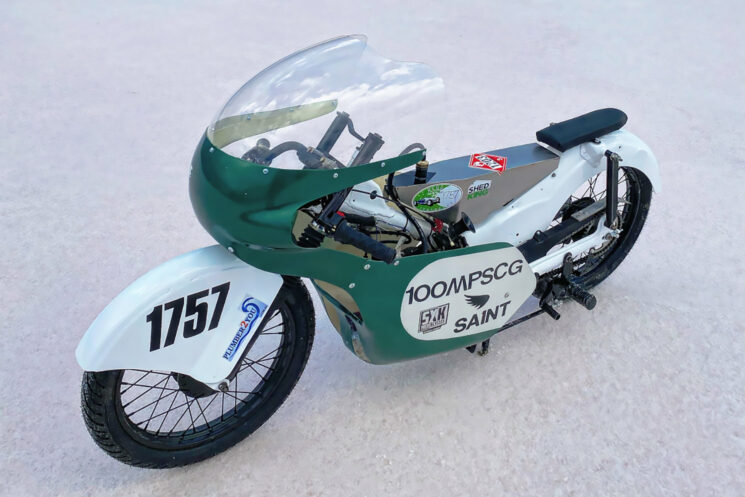
Honda CT90 land speed racer by SXK Moto No matter where you are from, you should be familiar with the Honda CT90. It was sold around the world before production mostly ended in 1979. We say ‘mostly,’ because there are a few places in the world where the CT90 went on to become as iconic as Vegemite on toast.
Yes, we’re talking about Australia and how Big Red’s scrappy scoot went on to dominate the local mail delivery industry. Before Amazon, before eBay, before almost every delivery method down under, there was the Honda CT90—or as we call it, the ‘postie bike.’ Some say they emerged in the late Cretaceous period and survived, virtually unchanged until they reluctantly evolved into the CT125 that they are today.
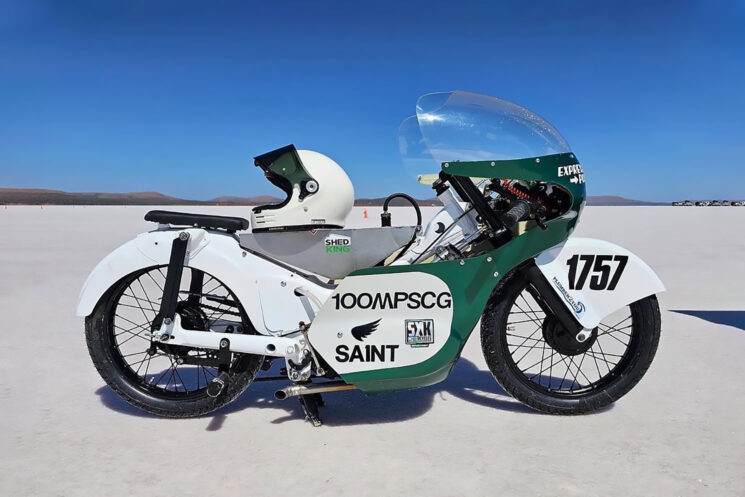
Straight from the Japanese factory, the Honda CT90 had a mind-boggling 7 hp on tap. The carbureted 89 cc powerhouse had an aluminum head, a dual-range gearbox, and… not a lot else, to be honest.
This postie bike, however, does have a lot else. This extreme CT90 was built by Matt Sheppard and Matt Kennedy, two enterprising Aussies that have joined forces to form SXK Moto. Based out of their workshop in Enfield, South Australia, they have built what is (possibly) the world’s fastest postie bike.
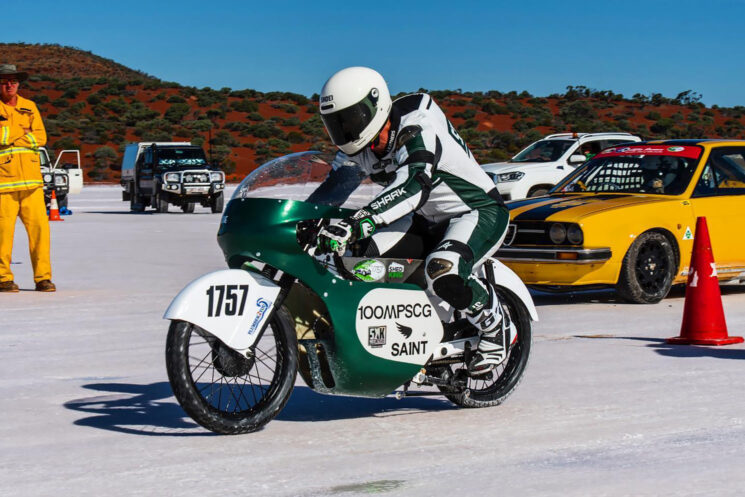
That’s right, this mail delivery machine lives for the salt flats. The boys wanted to compete in the 100-MPS-CG class (meaning up to 100 cc, modified, partially streamlined, classic and running on regular gasoline), and the CT90 seemed like the perfect starting point.
Matt ported the head and fitted a new intake manifold and exhaust. A 28 mm Yoshimura downdraft carb delivers the fuel and, amazingly, there’s a performance camshaft inside. Also, Matt found that by using a Honda CB175 piston (and some persuasion) he could get a bit closer to the 100 cc limit.
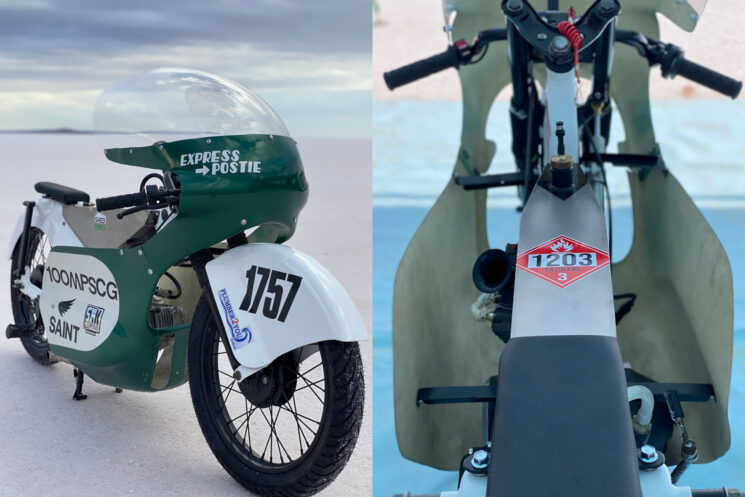
The hotted-up engine was then transplanted into a highly modified Honda CT110 frame. The front end was raked out, a steel wrap-around fender was fabricated for the front wheel (to slice through the air), and a Yamaha RD350 fairing was fitted. New handlebar mounts and a modified seat setup got Matt’s six foot-plus body tucked in behind the new fairing.
With the fabrication done, the bike got a fresh coat of paint to make it extra slippery.

The bike was completed just a few days before Speed Week, so the real test runs had to wait until the salt flats opened. After waiting for the weather and working through a few electrical and fueling issues, Matt was rewarded with a timing ticket of 66.06 mph. His average speed for all of his runs was 62.81 mph—the new Australian record for the 100-MPS-CG class.
“As a fun side note,” quips Matt, “I can’t find any info on a Honda CT90 with the standard engine going any faster. Is this the world’s fastest CT90? Maybe…” [Source]

Poulsen Motors electric motorcycle Tank bags are a bit dorky, but you can’t deny their convenience. Plus there are companies out there that make tank bags that actually look good. Well, if you like tank bags then you’re going to love this electric bike from Poulsen Motors in Denmark.
Poulsen has eschewed traditional motorcycle design in more ways than one. The first and most obvious way is something we’ve never seen before—using the tank space to stash a copious amount of luggage. Since an electric motorcycle has no need for fuel storage, Poulsen has flipped the script.
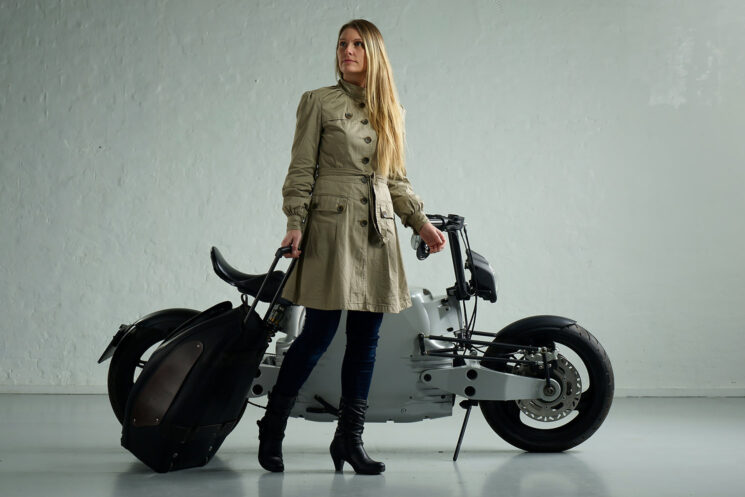
What we’re essentially looking at is 60% motorcycle and 40% tank bag. Poulsen calls their suitcase design a “lifestyle product that can be used with or without the bike.” They plan on releasing suitcase designs in different colors, sizes, and materials.
Buyers can choose which style they like or need, depending on their activities. Just nipping to the shops to grab a few things? Slip on a small bag. Going away for the weekend? Slide the full-size suitcase into place. Poulsen also plans to offer customers the same customization options for the seat.
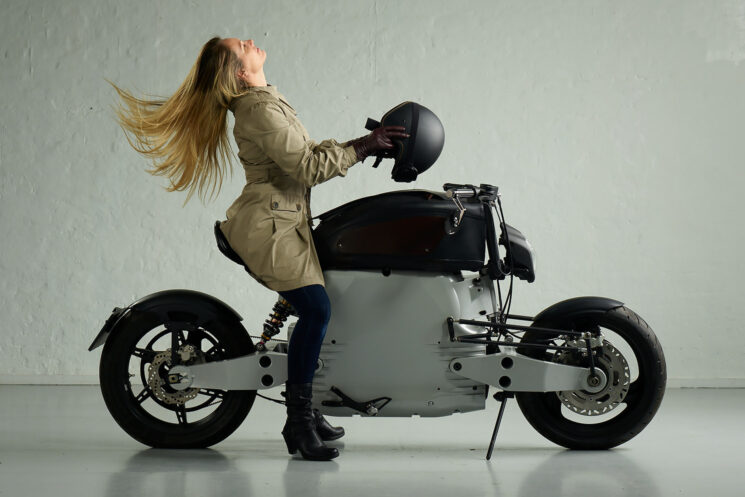
But the funk doesn’t stop there. Poulsen has also designed their concept with a less-than-traditional frame design. According to their website, each part is designed so simply that the same part can be used in several different places as a way of cutting down on manufacturing costs. We’ll gloss over the fact that hub-centered steering systems are wildly more complex and far more uncommon (and therefore more expensive) than a traditional motorcycle fork, but we appreciate the sentiment and dedication to the craft nonetheless.
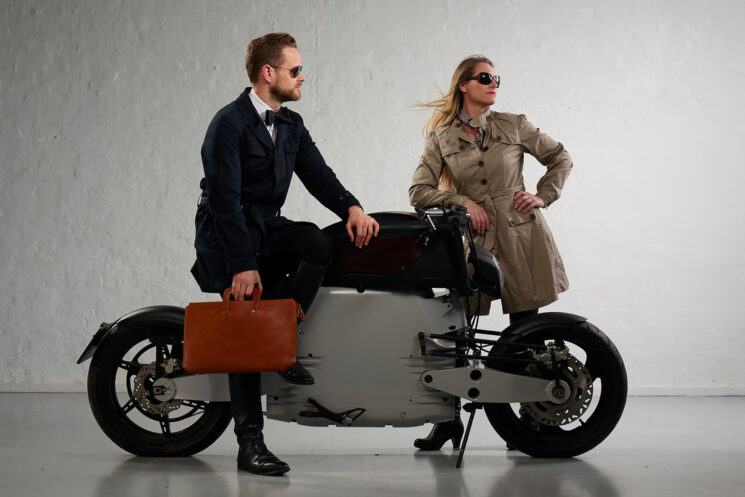
Smack bang in the middle of the bike sits the powerplant. It sports a beautifully designed casing and drives the rear wheel with a belt drive. Mono shocks and matching mudguards are used front and back, again to cut down on manufacturing costs. There are no range or power figures just yet, as the bike is still in the concept phase.
While the looks don’t necessarily light our fire, it’s certainly an interesting and practical package from the Danish firm. And it’s refreshing to see an electric bike with a useful ‘fuel tank.’ [Poulsen Motors]

Triumph Thunderbird Sport by Erik Before Triumph released their wildly popular Bonneville range, the British marque had already tried tapping into the retro market. That market was a far cry from what it is today in terms of popularity, but Triumph was trying nonetheless. Leading the charge was the Triumph Thunderbird 900.
Released in 1995, it had a 900 cc inline triple engine, a classic-shaped tank, and Triumph’s ‘portcullis’ tank badges. Side by side with a Hinckley twin, the Thunderbird 900 is an obvious relative.
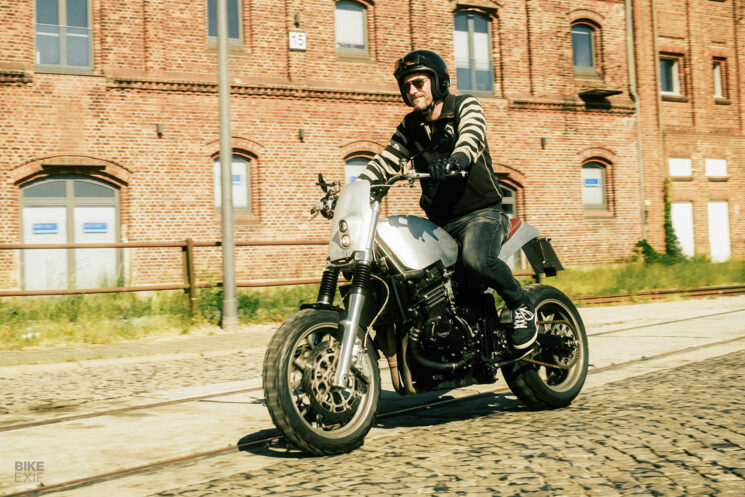
This particular Thunderbird started life as a Thunderbird Sport—the slightly more aggressive evolution of the Thunderbird, produced a few years later. This one’s owned by a German guy named Erik Wankerl, and is his interpretation of what a modern Thunderbird could look like.
To get a bit more pep out of the Thunderbird’s step, Erik swapped the engine out for another of Triumph’s triples—the Trident T300. Dyno tested at 108 hp, it’s got a lot more juice than the 70 hp Thunderbird, and it still manages to retain a few retro styling cues.
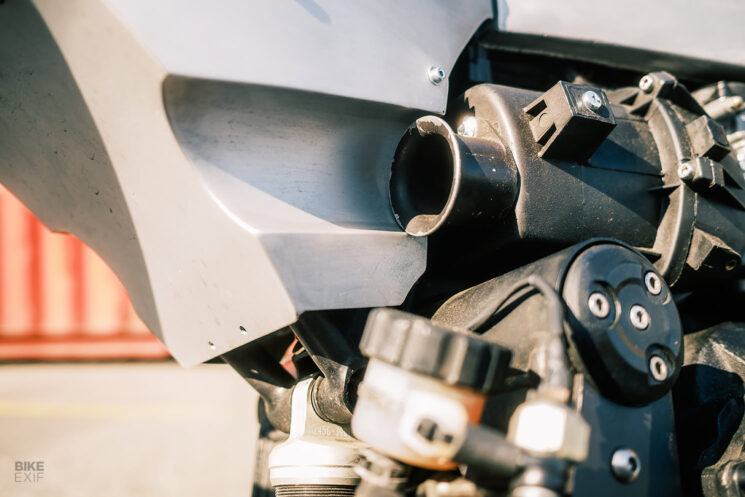
The bodywork, as you may have guessed, is all handmade from aluminum. The bike was sent off to Erik’s mate Ekkehard Homann, a mechanical engineer and artist, who made the exquisite bodywork from aluminum. The small front fairing houses a twin LED headlight and the fuel tank was designed to hug the engine, cutting a fine figure from all angles.
The combined seat and tail unit looks like something from an aircraft, which we love. An exquisite brown leather seat sits up top, while a small LED tail light rounds out the package.
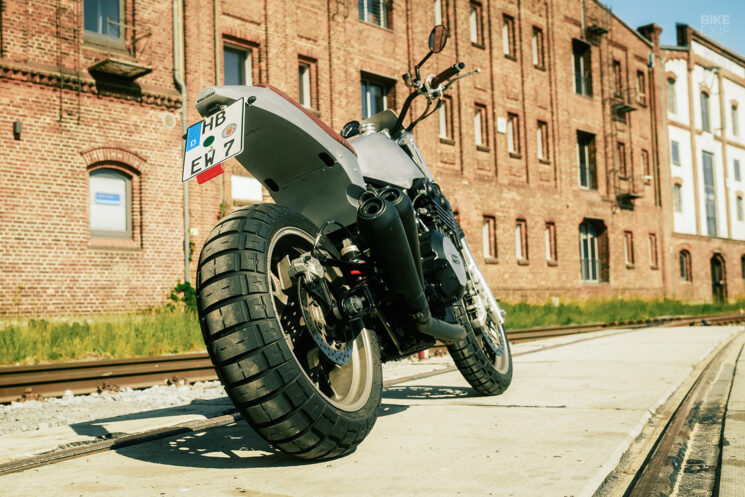
The wheels and brakes were donated by a Ducati 999, and look especially purposeful wrapped in Pirelli Scorpion Rally STR tires. The engine produces more than enough power but it was still treated to a new three-into-one-into-two exhaust. A YSS rear shock was bolted on to provide a more supple ride.
For a garage build, Erik and Ekkehard have done a stunning job with the Thunderbird, don’t you think? [Images by Ben Schmelter]
